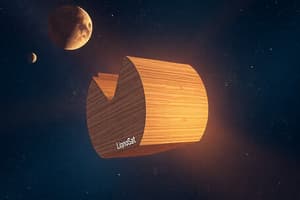Podcast
Questions and Answers
What is the primary environmental advantage of using wood in satellites like LignoSat, compared to traditional materials such as aluminum?
What is the primary environmental advantage of using wood in satellites like LignoSat, compared to traditional materials such as aluminum?
- Wood completely decomposes upon re-entry into Earth's atmosphere, leaving no trace of debris.
- Wood is more resistant to extreme temperatures, reducing the need for cooling systems that consume energy.
- Wood does not react with oxygen during atmospheric burn-up, minimizing the release of harmful particles. (correct)
- Wood is a renewable resource, unlike aluminum which requires extensive mining and processing.
Considering the experimental nature of the LignoSat project, what is the most significant risk factor that researchers must address to ensure mission success?
Considering the experimental nature of the LignoSat project, what is the most significant risk factor that researchers must address to ensure mission success?
- Maintaining a stable orbit altitude to prevent premature atmospheric re-entry due to the wood's low density.
- Preventing fungal or bacterial degradation of the wood in the humid environment of the International Space Station.
- Confirming the wood's long-term resistance to radiation and micrometeoroid impacts in the vacuum of space. (correct)
- Ensuring the satellite's wooden structure can withstand the initial launch vibrations and acceleration forces.
How might the success of the LignoSat project influence future satellite design and materials science, particularly in addressing the issue of space junk?
How might the success of the LignoSat project influence future satellite design and materials science, particularly in addressing the issue of space junk?
- It will likely shift investment away from traditional metal-based satellite construction towards research into sustainably sourced biopolymers.
- It may encourage the design of satellites with shorter operational lifespans to minimize the accumulation of space debris.
- It could spur further research into using alternative, environmentally friendly materials for satellite construction and disposal methods. (correct)
- It could lead to the development of international regulations mandating the use of biodegradable materials in all new satellites.
What motivated the selection of magnolia wood for the LignoSat project over other types of wood?
What motivated the selection of magnolia wood for the LignoSat project over other types of wood?
Considering the potential for future advancements in wooden satellite technology, what would be the most significant engineering challenge to overcome in order to build larger, more complex wooden spacecraft?
Considering the potential for future advancements in wooden satellite technology, what would be the most significant engineering challenge to overcome in order to build larger, more complex wooden spacecraft?
Flashcards
LignoSat
LignoSat
World's first satellite made mostly of wood.
LignoSat's Mission
LignoSat's Mission
To determine if wood can withstand space conditions and reduce space junk.
LignoSat Collaboration
LignoSat Collaboration
Kyoto University and Sumitomo Forestry.
LignoSat Wood Type
LignoSat Wood Type
Signup and view all the flashcards
Benefit of Wooden Satellites
Benefit of Wooden Satellites
Signup and view all the flashcards
Study Notes
- LignoSat is the world's first satellite made mostly from wood.
- LignoSat reached the International Space Station (ISS) aboard a SpaceX cargo capsule on November 5, 2024.
- The palm-sized satellite is named after the Latin word for "wood."
- LignoSat will launch from the ISS into Earth's orbit later this month.
- The mission is to determine if wood can withstand the harsh conditions of space.
- Success could lead to more environmentally friendly spacecraft designs.
LignoSat Space Wood Project
- Collaboration between Japan's Kyoto University and Sumitomo Forestry.
- Researchers sent a small panel of three wood samples to the ISS in 2022.
- The panel was exposed to space for ten months before returning to Earth in early 2023.
- Wood from magnolia trees was chosen for the satellite after analyzing the results.
- Professor Koji Murata of Kyoto University stated that engineers thought wood was old technology.
Purpose of Using Wood
- Testing a wooden satellite aims to reduce space junk.
- Current satellites made of aluminum react with oxygen in Earth's atmosphere.
- The reaction releases aluminum oxide particles, potentially damaging the ozone layer.
- Wooden satellites could alleviate the issue as they leave behind only water and carbon dioxide.
- Takao Doi, an aerospace engineer with Kyoto University, said satellites create alumina particles and affect the environment.
- LignoSat will orbit Earth for six months.
- Will gather data before burning up in the atmosphere.
- Aims to use the data to design larger, more advanced wooden satellites/devices.
Future Implications
- Researchers envision trees grown on the Moon and Mars.
- Successfully testing a wooden satellite proves wood can withstand harsh space conditions.
- Doi said timber allows humans to build houses, live, and work in space forever.
Studying That Suits You
Use AI to generate personalized quizzes and flashcards to suit your learning preferences.





